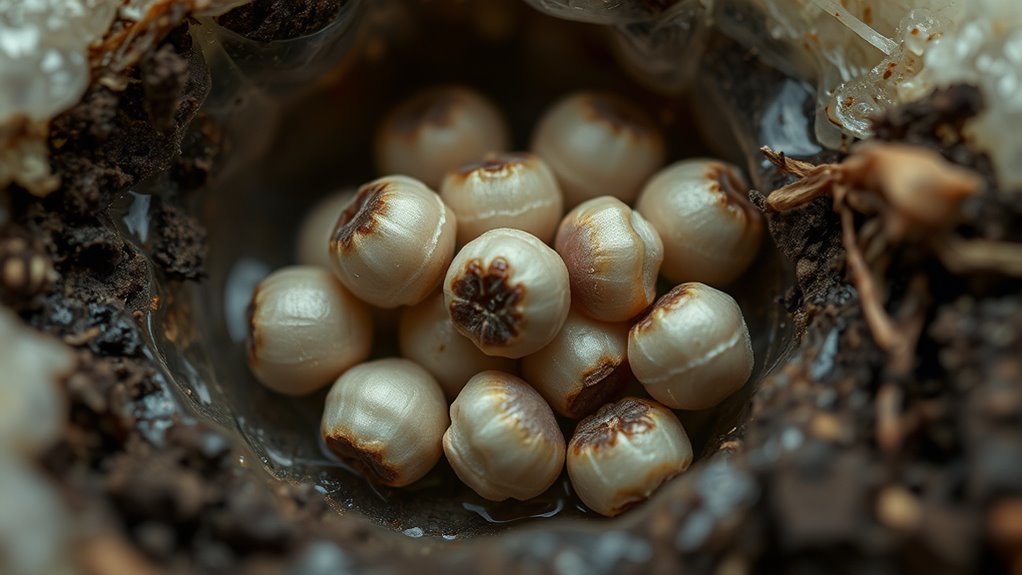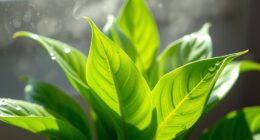When seeds are in stasis, they stay dormant until environmental cues like temperature, moisture, and light signal it’s time to wake up. These signals trigger physiological changes, such as water absorption, enzyme activation, and hormone shifts, which break seed coat dormancy and kickstart germination. The embryo then begins to grow, with the radicle emerging first. To discover the detailed steps behind this fascinating process, keep exploring how nature orchestrates seed awakening.
Key Takeaways
- Dormant seeds suspend metabolic activity, relying on protective seed coats for survival during adverse conditions.
- Environmental cues like temperature, moisture, and light signal the end of dormancy and trigger germination.
- Water absorption activates enzymes that mobilize stored nutrients, initiating internal physiological changes.
- Cold stratification and moisture perception lift dormancy inhibitors, allowing metabolic processes to resume.
- The radicle emerges first, followed by shoot growth, as internal hormones coordinate seedling development.

Seeds in stasis represent a remarkable adaptation that allows plants to survive extreme conditions by entering a state of suspended animation. When environmental factors turn harsh—like drought, cold, or lack of nutrients—the seed essentially hits pause. Its metabolic processes slow dramatically, conserving energy and resources until conditions become favorable again. During this dormancy phase, the seed’s protective coat shields the embryo from physical damage, pathogens, and dehydration. This resilience guarantees that, even in the harshest environments, some seeds remain viable, waiting patiently for the right moment to sprout. Additionally, the seed’s ability to maintain viability over extended periods underscores its dormancy mechanisms, which are vital for plant survival across seasons. Breaking dormancy is a critical step in the germination process, and it depends on specific cues that tell the seed it’s safe to resume growth. These cues can vary widely among species but often include temperature shifts, moisture availability, light exposure, or a combination of these factors. For instance, many seeds require a period of cold stratification—exposure to cold temperatures—to break dormancy. This process mimics winter conditions, signaling to the seed that spring is approaching. Once the seed perceives these signals, its inhibitory mechanisms are lifted, and metabolic activity ramps up. Enzymes activate, nutrients stored within the seed are mobilized, and cell division begins anew. Water plays a crucial role in this shift. As moisture infiltrates the seed coat, it triggers the swelling of cells and activates metabolic pathways. The seed absorbs water rapidly, which helps to loosen the seed coat, making it easier for the embryonic root, or radicle, to push out. This initial protrusion marks the beginning of germination. Simultaneously, the seed’s internal hormones, like gibberellins, stimulate the production of enzymes that break down stored starches and proteins into sugars and amino acids. These nutrients fuel the growth of the emerging seedling. Light can also influence germination, especially in species that depend on it to time their growth with favorable conditions. Once the radicle emerges, the seedling starts to grow downward into the soil, anchoring the plant and seeking water and nutrients. Meanwhile, the shoot begins to rise, searching for sunlight to power photosynthesis. The entire process showcases a finely tuned response to environmental cues, ensuring that germination occurs at a moment when the seedling has the best chance of survival. Your understanding of these mechanisms reveals just how adaptable and strategic seeds are—remaining dormant during tough times and springing into life when the conditions are right.
Frequently Asked Questions
How Do Seeds Sense Environmental Cues to Break Dormancy?
You can think of seeds sensing environmental cues as them “listening” for signals like temperature, moisture, and light. When conditions become favorable, they detect changes through chemical and physical processes in their seed coat and embryo. These cues trigger biochemical reactions, releasing hormones like gibberellins, which activate enzymes to break down stored food and start germination. fundamentally, seeds respond to their surroundings to decide the right moment to grow.
What Chemical Signals Trigger Germination in Dormant Seeds?
Imagine a tiny messenger from the future, whispering secrets to your seed. When conditions are right, hormones like gibberellins and abscisic acid act as chemical signals, telling the seed it’s time to grow. Gibberellins break down inhibitors and activate enzymes that loosen the seed coat, while other signals promote cell division. These coordinated messages kickstart germination, transforming dormant potential into vibrant life.
Can Seed Dormancy Be Artificially Broken in Labs?
Yes, seed dormancy can be artificially broken in labs. You typically expose seeds to specific treatments like scarification, stratification, or chemical cues such as gibberellic acid. These methods mimic natural environmental conditions, encouraging germination. By controlling temperature, moisture, and chemical signals, you can reliably break dormancy, which is especially useful for research, agriculture, or conservation efforts to ensure seeds sprout when needed.
How Do Different Seed Types Vary in Dormancy Mechanisms?
Think of seeds as tiny vaults holding secrets. Different types vary in how they keep these secrets secured away. Some require cold to open their potential, like winter’s whisper awakening spring. Others need fire or passage through an animal’s gut to reveal their true nature. These mechanisms symbolize nature’s diverse ways of ensuring survival, each seed’s dormancy a unique puzzle that nature skillfully solves to guarantee future growth.
What Role Do Microbial Interactions Play in Seed Germination?
Microbial interactions play a vital role in seed germination by influencing seed health and breaking dormancy. You might notice beneficial microbes, like certain fungi and bacteria, help activate enzymes that promote water absorption and nutrient uptake. These microbes can also suppress harmful pathogens, creating a healthier environment for the seed to sprout. By supporting these interactions, you enhance the chances of successful germination and healthy seedling development.
Conclusion
Now that you understand how seeds stay dormant until conditions are just right, it’s fascinating to realize that over 70% of plant species rely on dormancy to survive harsh environments. When conditions improve, these tiny powerhouses break free from stasis and begin germination, ensuring new life. So next time you see a seed, remember it’s not just waiting—it’s poised for an incredible transformation, ready to grow into something extraordinary. Nature’s resilience truly starts with a single seed.










